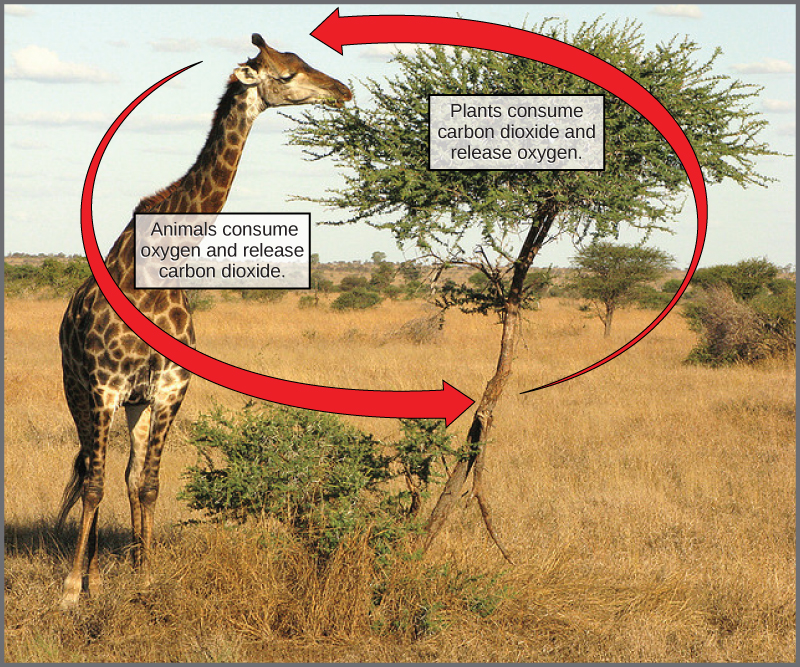Putting it Together: Metabolic Pathways
Whether the organism is a bacterium, plant, or animal, all living things access energy by breaking down carbohydrate molecules. But if plants make carbohydrate molecules, why would they need to break them down, especially when it has been shown that the gas organisms release as a “waste product” (CO2) acts as a substrate for the formation of more food in photosynthesis? Remember, living things need energy to perform life functions. An organism can either make its own food or eat another organism—either way, the food still needs to be converted to a form cells can actually use. In that process of conversion, called cellular respiration, organisms release needed energy and produce “waste” in the form of CO2 gas. These two metabolic processes that are crucial to life on earth– those that build sugars, and those that break them down– are deeply connected.
Breaking down glucose: Cellular respiration
As an example of an energy-releasing pathway, let’s see how one of your cells might break down a sugar molecule (say, from that candy you had for dessert).
Many cells, including most of the cells in your body, get energy from glucose (C6H12O6 ) in a process called cellular respiration. During this process, a glucose molecule is broken down gradually, in many small steps. However, the process has an overall reaction of:
C6H1206 + 6O2 → 6CO2 + 6H20 + energy
Breaking down glucose releases energy, which is captured by the cell in the form of ATP (adenosine triphosphate). ATP gives cells a convenient way to briefly store energy.
Once it’s made, ATP can be used by other reactions in the cell as an energy source. Much as we humans use money because it’s easier than bartering each time we need something, so the cell uses ATP to have a standardized way to transfer energy. Because of this, ATP is sometimes described as the “energy currency” of the cell.
Building up glucose: Photosynthesis
As an example of an energy-requiring metabolic pathway, let’s flip that last example around and see how a sugar molecule is built.
Sugars like glucose are made by plants in a process called photosynthesis. In photosynthesis, plants use the energy of sunlight to convert carbon dioxide gas into sugar molecules. Photosynthesis takes place in many small steps, but its overall reaction is just the cellular respiration reaction flipped backwards:
6CO2 + 6H20 + energy → C6H12O6 + 6O2
Like us, plants need energy to power their cellular processes, so some of the sugars are used by the plant itself. They can also provide a food source for animals that eat the plant, like the giraffe below (Figure 1). In both cases, the glucose will be broken down through cellular respiration, generating ATP to keep cells running.

In nature, there is no such thing as waste. Every single atom of matter and energy is conserved, recycling over and over infinitely. Substances change form or move from one type of molecule to another, but their constituent atoms never disappear (Figure 1).
While you may be tempted to call CO2 a waste product, you should remember that oxygen is a “waste product” of photosynthesis: CO2 and oxygen are byproducts of reactions that move on to other reactions. Photosynthesis absorbs light energy to build carbohydrates in chloroplasts, and aerobic cellular respiration releases energy by using oxygen to metabolize carbohydrates in the cytoplasm and mitochondria. Both processes use electron transport chains to capture the energy necessary to drive other reactions. These two powerhouse processes, photosynthesis and cellular respiration, function in biological, cyclical harmony to allow organisms to access life-sustaining energy that originates millions of miles away in a burning star humans call the sun.
CC Licensed Content, Shared Previously, Included in How Organisms Get Energy
- Biology for Majors I. Author: Shelly Carter. Provided by: Lumen Learning. Located at: Biology for Majors I | Simple Book Production. License: CC BY: Attribution 4.0.
- Overview of Metabolism. Provided by: Khan Academy. Located at: Overview of Metabolism (article) | Cellular Energy | Khan Academy License: CC BY-NC-SA 4.0

